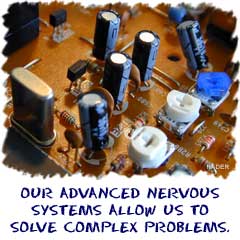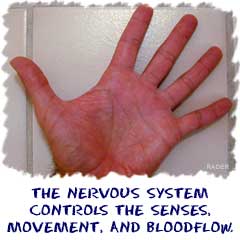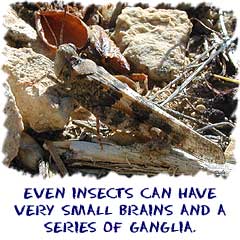
Nervous System - I'm Sensing Something
 Since you're reading this page, we figure you've got a nervous system. If you were an insect you would also have a nervous system, but it would be a lot simpler. Even animals that don't think have simple nervous systems called nerve nets that help them move.
Since you're reading this page, we figure you've got a nervous system. If you were an insect you would also have a nervous system, but it would be a lot simpler. Even animals that don't think have simple nervous systems called nerve nets that help them move.
Your nervous system is divided into two parts. Your central nervous system includes your brain and your spinal cord. Your peripheral nervous system is made up of the network of neurons that spans your organs, muscles, and body. The neurons in both systems work together to help you think, survive, and change the world around you.
What Does This System Do?
The nervous system is about action and senses. Animals are able to sense what is going on in their surroundings and do something in reaction to that input. If you see a bike that might hit you, you jump out of the way. In that example, your nervous system was involved in many ways. Your eyes saw the bike, your brain figured out the bike might hit you, and your brain told your muscles to make your legs jump out of the way. You sensed and then acted. The nervous system also senses activity inside of your body. Most of the nervous system response inside of your body is not in your control. Your body automatically senses and reacts to stimulus. Think about eating your lunch. As you eat, your nervous system triggers the start of digestion and release of many hormones and enzymes throughout your body.
The nervous system also senses activity inside of your body. Most of the nervous system response inside of your body is not in your control. Your body automatically senses and reacts to stimulus. Think about eating your lunch. As you eat, your nervous system triggers the start of digestion and release of many hormones and enzymes throughout your body.
Interacting with Other Systems
Your nervous system interacts with every other system in your body. In the same way that all of your cells need oxygen transported by the circulatory system, all of your tissues and organs require instruction and direction from the nervous system. There is obvious interaction between your muscles and your nervous system. That interaction helps you move around and interact with your environment.There are many hidden interactions going on within your body. Your endocrine system works closely with your brain and central nervous system to control the creation of specific hormones and enzymes. Your digestive and excretory systems work with the nervous system in both conscious and unconscious ways. While digestion goes on without your thoughts, eating, peeing, and pooping are under your control.
Parts of the System
 The nervous system is made up of nervous tissues that are, in turn, made up of many types of neurons. There are billions of neurons connected throughout your body. These neurons are connected end to end and transmit electrical impulses from one point to another.
The nervous system is made up of nervous tissues that are, in turn, made up of many types of neurons. There are billions of neurons connected throughout your body. These neurons are connected end to end and transmit electrical impulses from one point to another.
Your peripheral nervous system has two types of neurons that are constantly at work. Neurons that send impulses from the central nervous system to your limbs and organs are called efferent neurons. Neurons that receive sensory information and transmit to the central nervous system are called afferent neurons. Therefore, as the stimulus is received, the afferent neurons work and as reaction is needed, the efferent neurons go to work. Afferent=Receive. Efferent=Act. The words are really close to each other, that's why repeated the idea.
► NEXT PAGE ON ANIMAL SYSTEMS
► NEXT STOP ON SITE TOUR
► RETURN TO TOP OF PAGE
► Or search the sites...
► NEXT STOP ON SITE TOUR
► RETURN TO TOP OF PAGE
► Or search the sites...
Related Video...
In-Ear Headphone Redesign (US-NSF Video)
Encyclopedia.com:
http://www.encyclopedia.com/topic/nervous_system.aspx#2
Wikipedia:
http://en.wikipedia.org/wiki/Nervous_system
Encyclopædia Britannica:
http://www.britannica.com/EBchecked/topic/409709/human-nervous-system



